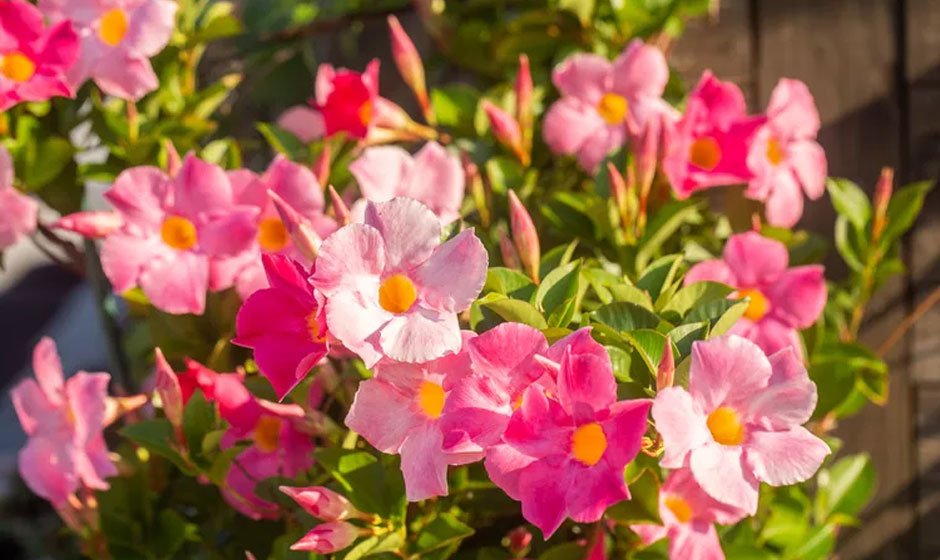Mandevilla, also known as rocktrumpet, is a beautiful flowering vine that thrives in tropical and subtropical climates. With trumpet-shaped blooms in shades of pink, red, and white, it adds a touch of elegance to any garden or landscape. In this article, we will explore the different types of mandevilla, as well as tips and tricks for caring for and growing this stunning plant on a trellis.
Types of Mandevilla
There are more than 100 species within the Mandevilla genus. Some of the most popular for outdoor cultivation include:
1. Mandevilla sanderi
Commonly known as Brazilian jasmine, this species of mandevilla is fast-growing, reaching up to 15 feet tall. It boasts twining, woody stems and large pink-red blooms.
2. Mandevilla boliviensis
Also known as white mandevilla, this species is notable for its delicate white blooms. It can grow between 3 and 10 feet tall with a 3- to 6-foot spread.
3. Mandevilla laxa
Known commonly as Chilean jasmine, this mandevilla species produces masses of heavily scented white flowers, reaching up to 20 feet tall.
Growing Mandevilla on a Trellis
Mandevilla vines are natural climbers and look stunning when grown on a trellis. Here are some tips for growing mandevilla on a trellis:
1. Select the Right Trellis
Choose a sturdy trellis that can support the weight of the vine as it grows. It should be tall enough to accommodate the height of the plant and wide enough to allow the vine to spread out.
2. Plant the Vine
Plant the vine at the base of the trellis and train it to climb up the structure. Gently wrap the stems around the trellis as it grows, using garden twine to secure it in place.
3. Provide Adequate Sunlight
Mandevilla thrives in full sun, so make sure the trellis is in a location that receives at least six hours of direct sunlight each day.
4. Water and Fertilize Regularly
Water the vine regularly, keeping the soil moist but not soggy. Fertilize the plant with a slow-release, balanced fertilizer in spring and mid-summer to promote healthy growth and abundant blooms.
5. Prune as Needed
Prune the vine as needed to maintain the desired shape and size. Cut back any diseased or damaged branches, as well as any branches that are creating a shape that you don’t desire for the plant.
Potting and Repotting Mandevilla
Caring for a potted mandevilla is easy. When first potting your mandevilla plant, choose a container that’s only slightly larger than the root ball. A container that’s too big can cause the plant to expend more energy on producing roots than growing flowers, so you might see fewer flowers until it has expanded its root system. Make sure the pot has ample drainage holes to help prevent root rot.
However, once you see roots creeping out of the container, it’s time to repot. Mandevillas are fast-growing plants, you’ll likely need to repot annually in spring. When doing so, select just one pot size up. Gently remove the root ball from the old container, set it in the new container, fill around it with fresh potting mix, and water well.
Common Pests and Diseases
Mandevilla plants generally don’t have any serious problems with diseases. However, they can attract pests, including red spider mites, scales, whiteflies, and aphids. You might notice tiny insects moving on your plants or see leaf damage and discoloration. If you have an infestation, apply insecticidal soap or horticultural oil (like neem oil) continually until all signs of infection have passed.
Common Problems with Mandevilla
This pretty and easy-care plant has a few problems, just like any other plant. Here’s what to do when you spot the following issues.
Yellowing Leaves
Your mandevilla plant will let you know if it’s feeling dry or otherwise ill by letting its leaves turn yellow and drop off. Too little water will make leaves yellow and curl. To repair, water the plant from the bottom, not the top, by immersing the pot in water for a few minutes so water reaches the roots.
Browning Leaves
A mandevilla with browning leaves is having the opposite problem of yellowing leaves. Brown leaves may mean the soil is too wet, the plant is in standing water, or the soil is not draining enough. Try fertilizing the plant and scheduling consistent waterings.
Brown Spots on Leaves
Brown spots and browning leaves mean two different things with mandevilla. Brown spots may indicate a case of a fungal disease called anthracnose. Overly wet leaves can lead to this disease and lead to dropping leaves, as well. Prune the affected leaves and treat the plant with a fungicide.
Frequently Asked Questions
1. When should I plant my mandevilla?
Mandevilla should be planted in mid-to-late spring once the temperature is reliably warm and the risk of frost has passed.
2. How often should I water my mandevilla?
Water the plant whenever the soil begins to dry out, aiming to keep the soil damp but not soggy.
3. How do I get my mandevilla to bloom?
Mandevilla requires ample light and proper fertilizing to produce bountiful blooms each summer. Feed the plant every two to three weeks during the growing season with a fertilizer that is high in phosphorus.
4. Can I grow mandevilla in a container?
Yes, mandevilla can be grown in a container. When first potting your mandevilla plant, choose a container that’s only slightly larger than the root ball. Repot annually in spring as needed.
Conclusion
Mandevilla is a beautiful and versatile plant that can add a touch of elegance to any garden or landscape. With trumpet-shaped blooms in shades of pink, red, and white, it’s perfect for growing on a trellis or in a container. By following the tips and tricks outlined in this guide, you can grow a healthy and abundant mandevilla that will be the envy of your neighborhood.

